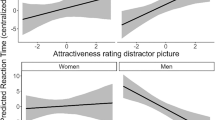Abstract
Women’s mating strategies are dependent on multiple factors, such as identifying which men advertise physical features indicating high genetic quality, as well as identifying which men are willing to invest in offspring. Research has suggested that women pursuing short-term mating prioritize physical attraction to facilitate the acquisition of good genes. Although it is known that physical characteristics are important in mate choice, research investigating the saliency of physical features in assessing male fitness has not been readily explored. The current study used an eye-tracking paradigm to investigate the role of short-term mating in women and their attraction and visual attention to men’s waist to chest ratios (WCRs). Women’s short-term mating orientation (N = 130) was associated with attraction to men with low WCRs; however, their visual attention was not influenced by their mating strategy. Interestingly, women who perceived themselves as attractive rated men with low WCRs as more attractive and allocated attentional resources to physical features important in mate choice, such as the head and midriff region. The findings from this study lend some support to sexual strategies theory (Buss & Schmitt, 1993) and strategic pluralism (Gangestad & Simpson, 2000), and they suggest that mate preferences may be calibrated as a function of one’s mate value.





Similar content being viewed by others
References
Alvergne, A., & Lummaa, V. (2010). Does the contraceptive pill alter mate choice in humans? Trends in Ecology & Evolution, 25(3), 171–179.
Andersson, M. (1994). Sexual selection. Princeton, NJ: Princeton University Press.
Bates, D., Machler, M., Bolker, B., & Walker, S. (2015). Fitting linear mixed-effects models using lme4. Journal of Statistical Software, 67(1), 1–48.
Borras-Guevara, M. L., Batres, C., & Perrett, D. I. (2019). Fear of violence among Columbian women is associated with reduced preferences for high-BMI men. Human Nature, 30, 341–369.
Braun, M. F., & Bryan, A. (2006). Female waist to hip and male waist to shoulder ratios as determinants of romantic partner desirability. Journal of Social and Personal Relationships, 23(5), 805–819.
Burriss, R. P., Marcinkowska, U. M., & Lyons, M. T. (2014). Gaze properties of women judging the attractiveness of masculine and feminine male faces. Evolutionary Psychology, 12(1), 19–35.
Buss, D. M., & Schmitt, D. P. (1993). Sexual strategies theory: An evolutionary perspective on human mating. Psychological Review, 100, 204–234.
Buss, D. M., & Schmitt, D. P. (2019). Mate preferences and their behavioral manifestations. Annual Review of Psychology, 70, 77–110.
Buss, D. M., & Shackelford, T. K. (2008). Attractive women want it all: Good genes, economic investment, parenting proclivities, and emotional commitment. Evolutionary Psychology, 6(1), 134–146.
Buunk, B. P., & Dijskstra, P. (2005). A narrow waist versus broad shoulders: Sex and age differences in the jealousy-evoking characteristics of a rival’s body build. Personality and Individual Differences, 39, 379–389.
Conklin, K., Pellicer-Sanchez, A., & Carrol, G. (2018). Eye-tracking: A guide for applied linguistics research. New York, NY: Cambridge University Press.
Coy, A. E., Green, J. D., & Price, M. E. (2014). Why is low waist-to-chest ratio attractive in males? The mediating roles of perceived dominance, fitness, and protection ability. Body Image, 11, 282–289.
Danel, D. P., Siennicka, A., Glinska, K., Fedurek, P., Nowak-Szczepanska, N., Jankowska, E. A., … Lewandowski, Z. (2017). Female perception of a partner’s mate value discrepancy and controlling behavior in romantic relationships. Acta Ethologica, 20(1), 1–8.
Dixson, A. F., Halliwell, G., East, R., Wignarajah, P., & Anderson, M. J. (2003). Masculine somatotype and hirsuteness as determinants of sexual attractiveness to women. Archives of Sexual Behavior, 32(1), 29–39.
Dixson, B. J., & Brooks, R. C. (2013). The role of facial hair in women’s perceptions of men’s attractiveness, health, masculinity, and parenting abilities. Evolution and Human Behavior, 34(3), 236–241.
Dixson, B. J., Grimshaw, G. M., Ormsby, D. K., & Dixson, A. F. (2014). Eye-tracking women’s preferences for men’s somatotypes. Evolution and Human Behavior, 35, 73–79.
Durkee, P., Goetz, A. T., & Lukaszewski, A. (2017). Formidability assessment mechanisms: Examining their speed and automaticity. Evolution and Human Behavior, 39(2), 170–178.
Edlund, J. E., & Sagarin, B. J. (2010). Mate value and mate preferences: An investigation into decisions made with and without constraints. Personality and Individual Differences, 49, 835–839.
Ellis, B. J., McFayden-Ketchum, S., Dodge, K. A., Petit, G. S., & Bates, J. E. (1999). Quality of early family relationships and individual differences in the timing of pubertal maturation in girls: A longitudinal test of an evolutionary model. Journal of Personality and Social Psychology, 77(2), 387–401.
Fan, J., Dai, W., Liu, F., & Wu, J. (2005). Visual perception of male body attractiveness. Proceedings of the Royal Society B: Biological Sciences, 265, 927–933.
Folstad, I., & Karter, A. J. (1992). Parasites, bright males, and the immunocompetence handicap. The American Naturalist, 139(3), 603–622.
Gangestad, S. W., & Scheyd, G. J. (2005). The evolution of human physical attractiveness. Annual Review of Anthropology, 34, 523–548.
Gangestad, S. W., & Simpson, J. A. (2000). The evolution of human mating: Trade-offs and strategic pluralism. Behavioral and Brain Sciences, 23, 573–644.
Garza, R., & Byrd-Craven, J. (2019). Fertility status in visual processing of men’s attractiveness. Evolutionary Psychological Science, 5, 328–342.
Garza, R., Heredia, R. R., & Cieslicka, A. B. (2017). An eye tracking examination of men’s attractiveness by conceptive risk women. Evolutionary Psychology, 15(1), 1–11.
Geary, D. C. (2000). Evolution and proximate expression of human paternal investment. Psychological Bulletin, 126, 55–77.
Geary, D. C. (2009). Male, female: The evolution of human sex differences. Washington, DC: American Psychological Association.
Gildersleeve, K., Haselton, M. G., & Fales, M. R. (2014). Do women’s mate preferences change across the ovulatory cycle? A meta-analytic review. Psychological Bulletin, 140, 1205–1259.
Griskevicius, V., Goldstein, N. J., Mortensen, C. R., Cialdini, R. B., & Kenrick, D. T. (2006). Going along versus going alone: When functional motives facilitate strategic (non)conformity. Journal of Personality and Social Psychology, 91(2), 281–294.
Hughes, S. M., & Gallup, G. G. (2002). Sex differences in morphological predictors of sexual behavior: Shoulder to hip and waist to hip ratios. Evolution and Human Behavior, 24, 173–178.
Jackson, J. J., & Kirkpatrick, L. A. (2007). The structure and measurement of human mating strategies: Toward a multidimensional model of sociosexuality. Evolution and Human Behavior, 28, 382–391.
Kasperk, C., Helmboldt, A., Borcsok, I., Heuthe, S., Cloos, O., Niethard, F., & Ziegler, R. (1997). Skeletal site dependent expression of the androgen receptor in human osteoblastic cell populations. Calcified Tissue, 61, 464–473.
Krupp, D. B. (2008). Through evolution’s eyes: Extracting mate preferences by linking visual attention to adaptive design. Archives of Sexual Behavior, 37, 57–63.
Lassek, W. D., & Gaulin, S. J. C. (2009). Costs and benefits of fat-free muscle mass in men: Relationships to mating success, dietary requirements, and native immunity. Evolution and Human Behavior, 30(5), 322–328.
Li, N. P., & Kenrick, D. T. (2006). Sex similarities and differences in preferences for short-term mates: What, whether, and why. Journal of Personality and Social Psychology, 90(3), 468–489. https://doi.org/10.1037/0022-3514.90.3.468.
Little, A. C., Burt, D. M., Penton-Voak, I. S., & Perrett, D. I. (2001). Self-perceived attractiveness influences human female preferences for sexual dimorphism and symmetry in male faces. Proceedings of the Royal Society B: Biological Sciences, 268, 39–44.
Little, A. C., Cohen, D. L., Jones, B. C., & Belsky, J. (2007). Human preferences for facial masculinity change with relationship type and environmental harshness. Behavioral Ecology and Sociobiology, 61, 967–973.
Little, A. C., Connely, J., Feinberg, D. R., Jones, B. C., & Roberts, S. C. (2011). Human preferences for masculinity differs according to context in faces, bodies, voices, and smell. Behavioral Ecology, 22, 862–868.
Little, A. C., DeBruine, L. M., & Jones, B. C. (2013). Environment contingent preferences: Exposure to visual cues of direct male–male competition and wealth increase women’s preference for masculinity in male faces. Evolution and Human Behavior, 34, 193–200.
Little, A. C., Jones, B. C., Penton-Voak, I. S., Burt, D. M., & Perrett, D. I. (2002). Partnership status and the temporal context of relationships influence human female preferences of sexual dimorphism in male face shape. Proceedings of the Royal Society B: Biological Sciences, 269, 1095–1193.
Maisey, D. S., Vale, E. L. E., Cornelissen, P. L., & Tovee, M. J. (1999). Characteristics of male attractiveness for women. The Lancet, 353, 1500.
Maner, J. K., Kenrick, D. T., Becker, V., Robertson, T. E., Hofer, B., Neuberg, S. L., … Schaller, M. (2005). Functional projections: How fundamental social motives can bias interpersonal perception. Interpersonal Relations and Group Processes, 88(1), 63–78.
Marcinkowska, U. M., Rantala, M. J., Lee, A. J., Kozlov, M. V., Aavik, T., Cai, H., … Dixson, B. J. W. (2019). Scientific Reports, 9, 1–9.
Pazhoohi, F., Garza, R., Doyle, J. F., Macedo, A. F., & Arantes, J. (2019). Sex differences for preferences of shoulder to hip ratio in men and women: An eye tracking study. Evolutionary Psychological Sciences, 5, 405–415.
Penton-Voak, I. S., Little, A. C., Jones, B. C., Burt, D. M., Tidderman, B. P., & Perrett, D. I. (2003). Female condition influences preference for sexual dimorphism in faces of male Homo Sapiens. Comparative Psychology, 117, 264–271.
Perrett, D. I., Lee, K. J., Penton-Voak, I., Rowland, D., Yoshikawa, S., Burt, D. M., … Akamatsu, S. (1998). Effects of sexual dimorphism on facial attractiveness. Nature, 394, 884–887.
Price, M. E., Brown, S., Dukes, A., & Kang, J. (2015). Bodily attractiveness and egalitarianism are negatively related in males. Evolutionary Psychology, 13(1), 140–166.
Provost, M. P., Komos, C., Kosakoski, G., & Quinsey, V. L. (2006). Sociosexuality in women and preference for facial masculinization and somatotype in men. Archives of Sexual Behavior, 35, 305–312.
Provost, M. P., Troje, N. F., & Quinsey, V. L. (2008). Short-term mating strategies and attraction to masculinity in point-light walkers. Evolution & Human Behavior, 29, 65–69.
Puts, D. A. (2010). Beauty and the beast: Mechanisms of sexual selection in humans. Evolution and Human Behavior, 31, 157–175.
Quinsey, V. L., Ketsetzis, M., Earls, C., & Karamanoukian, A. (1996). Viewing time as a measure of sexual interest. Ethology and Sociobiology, 17, 341–354.
Russell, L. (2019). Emmeans: Estimated marginal means, aka least-squares means. R package version 1.3.2. https://CRAN.R-project.org/package=emmeans
Schacht, R., Davis, H. E., & Kramer, K. L. (2018). Patterning of paternal investment in response to socioecological change. Frontiers in Ecology and Evolution, 6(142). https://doi.org/10.3389/fevo.2018.00142.
Scott, I. M., Clark, A. P., Josephson, S. C., Boyette, A. H., Cuthill, I. C., Fried, R. L., … Penton-Voak, I. S. (2014). Human preferences for sexually dimorphic faces may be evolutionary novel. Proceedings of the National Academy of Sciences, 111(40), 14388–14393.
Sell, A., Cosmides, L., Tooby, J., Sznycer, D., von Reuden, C., & Gurven, M. (2009). Human adaptations for the visual assessment of strength and fighting ability from the body and face. Proceedings of the Royal Society B: Biological Sciences, 276, 575–584.
Sell, A., Lukaszewski, A. W., & Townsley, M. (2017). Cues of upper body strength account for most of the variance in men’s bodily attractiveness. Proceedings of the Royal Society B: Biological Sciences, 284(1869), 1–9.
Swami, V., & Tovee, M. J. (2005). Male physical attractiveness in Britain and Malaysia: A cross-cultural study. Body Image, 2, 383–393.
Trivers, R. (1972). Parental investment and sexual selection. In Sexual selection & the descent of Man, 1871–1971 (pp. 136–179). New York: Aldine de Grutyer.
Acknowledgments
The authors would like to thank Montrey Bond, Lindsay Ashlynn Owens, and Annie Sands for conducting the study. We would also like to thank Alessio Lopez for manipulating the images.
Author information
Authors and Affiliations
Corresponding author
Ethics declarations
Conflict of interest
The authors declare that there are no conflicts of interest.
Ethics Approval
Ethics approval was granted by the Institutional Review Board at Oklahoma State University on September 10, 2018, approval code: AS-18-105.
Informed Consent
All participants in this research provided informed consent.
Additional information
Publisher's Note
Springer Nature remains neutral with regard to jurisdictional claims in published maps and institutional affiliations.
Rights and permissions
About this article
Cite this article
Garza, R., Byrd-Craven, J. Effects of Women’s Short-Term Mating Orientation and Self-Perceived Attractiveness in Rating and Viewing Men’s Waist to Chest Ratios. Arch Sex Behav 50, 543–551 (2021). https://doi.org/10.1007/s10508-020-01846-0
Received:
Revised:
Accepted:
Published:
Issue Date:
DOI: https://doi.org/10.1007/s10508-020-01846-0




